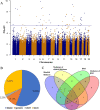The mediating effect of DNA methylation in the association between maternal sleep during pregnancy and offspring adiposity status: a prospective cohort study
- PMID: 35596190
- PMCID: PMC9123687
- DOI: 10.1186/s13148-022-01284-w
The mediating effect of DNA methylation in the association between maternal sleep during pregnancy and offspring adiposity status: a prospective cohort study
Abstract
Background: Childhood overweight/obesity is a global public health concern. It is important to identify its early-life risk factors. Maternal poor sleep is common in late pregnancy, and previous studies indicated that poor sleep may influence the offspring's adiposity status. However, very few studies in humans investigated the effect of the different sleep parameters (sleep quantity, quality, and timing) on the offspring's adiposity indicators, and long-term studies are even more scarce. In addition, the underlying mechanism remains unclear. The present study therefore aimed to examine the association between the three maternal sleep dimensions in the late pregnancy and the offspring adiposity indicators and to explore the potential mediating effect of the cord blood DNA methylation in the above association.
Methods: Included participants in the current study were 2211 healthy pregnant women with singleton gestation from the Shanghai Birth Cohort (SBC) and Shanghai Sleep Birth Cohort (SSBC). Maternal nighttime sleep duration, quality, and midpoint (an indicator of circadian rhythm) were assessed by the same instrument in both cohorts during late pregnancy, and the offspring's body mass index (BMI) and subcutaneous fat (SF) were measured at 2 years old. Additionally, in 231 SSBC samples, the genome-wide DNA methylation levels were measured using the Illumina Infinium Methylation EPIC BeadChip. The multivariate linear regression was used to determine the associations between the maternal sleep parameters and the offspring adiposity indicators. The epigenome-wide association study was conducted to identify the maternal sleep-related CpG sites. The mediation analysis was performed to evaluate the potential intermediate role of DNA methylation in the association between maternal sleep and offspring adiposity indicators.
Results: The mean maternal nighttime sleep duration and the sleep midpoint for combined cohorts were 9.24 ± 1.13 h and 3.02 ± 0.82, respectively, and 24.5% of pregnant women experienced poor sleep quality in late pregnancy. After adjusting for the covariates, the maternal later sleep midpoint was associated with the increased SF in offspring (Coef. = 0.62, 95% CI 0.37-0.87, p < 0.001) at 2 years old. However, no significant associations of the nighttime sleep duration or sleep quality with the offspring adiposity indicators were found. In the SSBC sample, 45 differential methylated probes (DMPs) were associated with the maternal sleep midpoint, and then, we observed 10 and 3 DMPs that were also associated with the offspring's SF and BMI at 2 years, of which cg04351668 (MARCH9) and cg12232388 significantly mediated the relationship of sleep midpoint and SF and cg12232388 and cg12225226 mediated the sleep midpoint-BMI association, respectively.
Conclusions: Maternal later sleep timing in late pregnancy was associated with higher childhood adiposity in the offspring. Cord blood DNA methylation may play a mediation role in that relationship.
Keywords: Childhood adiposity; Cord blood; DNA methylation; Late pregnancy; Sleep midpoint.
© 2022. The Author(s).
Conflict of interest statement
The authors declare that they have no competing interests.
Figures


Similar articles
-
Maternal pre-pregnancy BMI, offspring epigenome-wide DNA methylation, and childhood obesity: findings from the Boston Birth Cohort.BMC Med. 2023 Aug 23;21(1):317. doi: 10.1186/s12916-023-03003-5. BMC Med. 2023. PMID: 37612641 Free PMC article.
-
Maternal pre-pregnancy BMI and gestational weight gain, offspring DNA methylation and later offspring adiposity: findings from the Avon Longitudinal Study of Parents and Children.Int J Epidemiol. 2015 Aug;44(4):1288-304. doi: 10.1093/ije/dyv042. Epub 2015 Apr 8. Int J Epidemiol. 2015. PMID: 25855720 Free PMC article.
-
Maternal postload 1-hour glucose level during pregnancy and offspring's overweight/obesity status in preschool age.BMJ Open Diabetes Res Care. 2020 Feb;8(1):e000738. doi: 10.1136/bmjdrc-2019-000738. BMJ Open Diabetes Res Care. 2020. PMID: 32049640 Free PMC article.
-
Offspring body size and metabolic profile - effects of lifestyle intervention in obese pregnant women.Dan Med J. 2014 Jul;61(7):B4893. Dan Med J. 2014. PMID: 25123127 Review.
-
DNA methylation changes in cord blood and the developmental origins of health and disease - a systematic review and replication study.BMC Genomics. 2022 Mar 19;23(1):221. doi: 10.1186/s12864-022-08451-6. BMC Genomics. 2022. PMID: 35305575 Free PMC article.
Cited by
-
Mediation analysis in longitudinal study with high-dimensional methylation mediators.Brief Bioinform. 2024 Sep 23;25(6):bbae496. doi: 10.1093/bib/bbae496. Brief Bioinform. 2024. PMID: 39406521 Free PMC article.
-
Effects of prenatal and postnatal melatonin supplementation on overall performance, male reproductive performance, and testicular hemodynamics in beef cattle.J Anim Sci. 2023 Jan 3;101:skad111. doi: 10.1093/jas/skad111. J Anim Sci. 2023. PMID: 37052981 Free PMC article.
-
Mediating effects of DNA methylation in the association between sleep quality and infertility among women of childbearing age.BMC Public Health. 2023 Sep 15;23(1):1802. doi: 10.1186/s12889-023-16681-w. BMC Public Health. 2023. PMID: 37715240 Free PMC article.
-
Early-to-mid pregnancy sleep and circadian markers in relation to birth outcomes: An epigenetics pilot study.Chronobiol Int. 2023 Sep 2;40(9):1224-1234. doi: 10.1080/07420528.2023.2256854. Epub 2023 Oct 9. Chronobiol Int. 2023. PMID: 37722702 Free PMC article.
-
The Importance of Sleep in Overcoming Childhood Obesity and Reshaping Epigenetics.Biomedicines. 2024 Jun 15;12(6):1334. doi: 10.3390/biomedicines12061334. Biomedicines. 2024. PMID: 38927541 Free PMC article. Review.
References
-
- Sung H, Siegel RL, Torre LA, et al. Global patterns in excess body weight and the associated cancer burden. CA: Cancer J Clin. 2019;69(2):88–112. - PubMed
Publication types
MeSH terms
LinkOut - more resources
Full Text Sources
Medical

